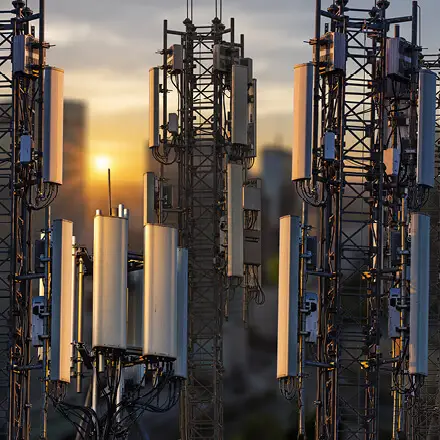Published on 22 February 2024
What is electromagnetic radiation (EMR)?
Electromagnetic radiation (EMR) and electromagnetic waves and fields (EMF) are actually natural. They are caused by lightning, in the earth's atmosphere and in deep layers of rock. However, there are also artificially generated EMR and EMFs caused by electronic devices and digital technologies such as smartphones and tablets. In these technologies, they are used for the digital transmission of information, for example in the form of text, images and sound.
This radiation can also be used to transmit information. Everywhere around us there is electromagnetic radiation that carries information. For example, when you use your smartphone or the internet, you use electromagnetic radiation to send and receive data.

Electromagnetic fields (EMF) and electromagnetic waves are specific types of electromagnetic radiation (EMR) that also transport information, but have different properties and applications.

Auroras occur when charged particles (electrons and protons) from the sun collide with the magnetic field of the Earth's atmosphere. When the energetic particles then combine with the earth's atoms, we see this in the form of the aurora borealis.
The sun is also an important natural source of electromagnetic radiation (EMR). The sun emits electromagnetic waves, but not all of these waves are visible. What we see is sunlight (the so-called visible light spectrum). The non-visible waves range from ultraviolet or infrared radiation to radio waves and even gamma rays. These rays and waves are absorbed by the atmosphere, so they generally cannot harm us.
Electromagnetic radiation (EMR) is also generated in deep layers of the earth's rock , for example due to thermal effects or the movement of the earth's plates (tectonic plates).
Weak electromagnetic waves and fields are even generated in the human body. This is because biological cells, including nerve and muscle cells, communicate and interact with each other using electrical signals. Our nervous system, for example, uses electromagnetic impulses to transmit information between the brain, the spinal cord and the peripheral nerves.
Electrosmog is created wherever electricity flows - i.e. in computers, televisions, refrigerators, ovens, washing machines, coffee machines, etc. However, the largest source of electrosmog is electromagnetic radiation caused by wireless technology, i.e. mobile phones, Wi-Fi, Bluetooth, RFID and digital devices in general – from smartphones and tablets to Wi-Fi routers, Bluetooth headphones and digital games consoles.
The problem: Our bodies are good at compensating for natural electromagnetic radiation. However, artificial electromagnetic radiation, electrosmog - is now so high that our bodies can no longer compensate for it on a long-term basis. We are literally being energised – and around the clock, because digital devices generate electromagnetic radiation, electromagnetic waves and fields even when we are not using them.

The effects: An increasing number of people are feeling the effects of this constant stress, e.g. through tiredness, headaches, sleep disorders, concentration problems, irritability and much more. Over the past few years, a growing number of scientists around the world have been studying the effects of electromagnetic radiation.
The evidence: There are now around 1,000 studies in which the harmful effects of electromagnetic radiation on the organism have been scientifically proven: from a weakening of the immune system to impaired fertility. The latter was demonstrated, for example, in the STOA study commissioned by the EU Parliament. In it, scientists analysed the effects of 5G for the first time.
The original study can be found on the EU Parliament's website:
View study
Ionising radiation: Ionising radiation, as found in X-rays and gamma rays, has enough energy to ionise atoms and molecules and cause damage to body cells and tissues. Therefore, special precautions and safety measures are required when handling ionising radiation, especially in medical areas such as computer tomography (CT) and radiotherapy.
Non-ionising radiation: Electromagnetic radiation (EMS), which is used in everyday technologies such as smartphones, Wi-Fi routers and microwaves, is classified as non-ionising radiation. In other words, this type of radiation does not have enough energy to ionise atoms or molecules.
As a result, non-ionising radiation, such as that emitted by smartphones, is generally considered harmless as long as it is within certain limits.
Learn more about limit values

However, experts are now questioning this and even providing evidence to the contrary: Around 1,000 studies worldwide now show that non-ionising radiation can have an effect on the body and its biochemical processes. Both the duration of exposure to radiation (exposure) and the intensity of the electromagnetic radiation (EMR) can influence the risks. This means that anyone who is exposed to high levels of radiation over the long term or even permanently – as is the case with daily smartphone use – is taking a health risk.
Extract from scientific studies
Download checklist
For everything that cannot be reduced or that you cannot do without, there is the memonizer. There is now a suitable memonizer for almost every digital device that compensates for electromagnetic radiation. This makes using your smartphone or Skyping with your tablet safe again.
What is the difference between EMR, EMF and electromagnetic waves?
Electromagnetic radiation (EMR) is the general term for any type of radiation consisting of electric, magnetic and electromagnetic fields and waves. EMR is like an invisible kind of energy travelling through space – like sunlight, for example.This radiation can also be used to transmit information. Everywhere around us there is electromagnetic radiation that carries information. For example, when you use your smartphone or the internet, you use electromagnetic radiation to send and receive data.

Electromagnetic fields (EMF) and electromagnetic waves are specific types of electromagnetic radiation (EMR) that also transport information, but have different properties and applications.
Natural electromagnetic radiation (EMR)
Physical and biological processes generate electromagnetic radiation as well as electromagnetic waves and fields. Lightning, for example, is the result of particularly strong electromagnetic fields within a thundercloud.
Auroras occur when charged particles (electrons and protons) from the sun collide with the magnetic field of the Earth's atmosphere. When the energetic particles then combine with the earth's atoms, we see this in the form of the aurora borealis.
The sun is also an important natural source of electromagnetic radiation (EMR). The sun emits electromagnetic waves, but not all of these waves are visible. What we see is sunlight (the so-called visible light spectrum). The non-visible waves range from ultraviolet or infrared radiation to radio waves and even gamma rays. These rays and waves are absorbed by the atmosphere, so they generally cannot harm us.
Electromagnetic radiation (EMR) is also generated in deep layers of the earth's rock , for example due to thermal effects or the movement of the earth's plates (tectonic plates).
Weak electromagnetic waves and fields are even generated in the human body. This is because biological cells, including nerve and muscle cells, communicate and interact with each other using electrical signals. Our nervous system, for example, uses electromagnetic impulses to transmit information between the brain, the spinal cord and the peripheral nerves.
Artificial electromagnetic radiation (EMR)
Electromagnetic radiation (EMR), waves and fields (EMF) are therefore primarily natural phenomena. But there are also artificial EMS and EMF. These are created by modern electronic devices and digital technologies. This type of electromagnetic radiation is also known colloquially as electrosmog.Electrosmog is created wherever electricity flows - i.e. in computers, televisions, refrigerators, ovens, washing machines, coffee machines, etc. However, the largest source of electrosmog is electromagnetic radiation caused by wireless technology, i.e. mobile phones, Wi-Fi, Bluetooth, RFID and digital devices in general – from smartphones and tablets to Wi-Fi routers, Bluetooth headphones and digital games consoles.
Is electromagnetic radiation harmful?
The average person now owns 3.5 digital devices. As a result, electromagnetic radiation (EMR) has increased massively in recent years. We now live surrounded by electromagnetic radiation around the clock – whether we are sleeping, working, doing sport, or spending time with our children or friends.The problem: Our bodies are good at compensating for natural electromagnetic radiation. However, artificial electromagnetic radiation, electrosmog - is now so high that our bodies can no longer compensate for it on a long-term basis. We are literally being energised – and around the clock, because digital devices generate electromagnetic radiation, electromagnetic waves and fields even when we are not using them.

The effects: An increasing number of people are feeling the effects of this constant stress, e.g. through tiredness, headaches, sleep disorders, concentration problems, irritability and much more. Over the past few years, a growing number of scientists around the world have been studying the effects of electromagnetic radiation.
The evidence: There are now around 1,000 studies in which the harmful effects of electromagnetic radiation on the organism have been scientifically proven: from a weakening of the immune system to impaired fertility. The latter was demonstrated, for example, in the STOA study commissioned by the EU Parliament. In it, scientists analysed the effects of 5G for the first time.
The original study can be found on the EU Parliament's website:
View study
What is the difference between ionising and non-ionising radiation?
With electromagnetic radiation, a distinction is made between ionising radiation and non-ionising radiation.Ionising radiation: Ionising radiation, as found in X-rays and gamma rays, has enough energy to ionise atoms and molecules and cause damage to body cells and tissues. Therefore, special precautions and safety measures are required when handling ionising radiation, especially in medical areas such as computer tomography (CT) and radiotherapy.
Non-ionising radiation: Electromagnetic radiation (EMS), which is used in everyday technologies such as smartphones, Wi-Fi routers and microwaves, is classified as non-ionising radiation. In other words, this type of radiation does not have enough energy to ionise atoms or molecules.
As a result, non-ionising radiation, such as that emitted by smartphones, is generally considered harmless as long as it is within certain limits.
Learn more about limit values

However, experts are now questioning this and even providing evidence to the contrary: Around 1,000 studies worldwide now show that non-ionising radiation can have an effect on the body and its biochemical processes. Both the duration of exposure to radiation (exposure) and the intensity of the electromagnetic radiation (EMR) can influence the risks. This means that anyone who is exposed to high levels of radiation over the long term or even permanently – as is the case with daily smartphone use – is taking a health risk.
Extract from scientific studies
What can be done about the harmful effects of electromagnetic radiation?
Artificial electromagnetic radiation, known as electrosmog, now surrounds us around the clock. Even if we switch off our smartphone and all other digital devices, there is still a lot of radiation around us: from Wi-Fi networks, mobile phone masts and much more. Nevertheless, you can take a few simple measures in your home or workplace to reduce electromagnetic radiation, electromagnetic waves and fields:Download checklist
For everything that cannot be reduced or that you cannot do without, there is the memonizer. There is now a suitable memonizer for almost every digital device that compensates for electromagnetic radiation. This makes using your smartphone or Skyping with your tablet safe again.










